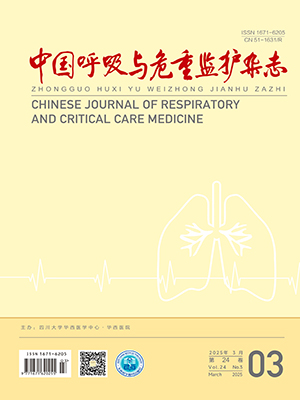| 1. |
Brassington K, Selemidis S, Bozinovski S, et al. New frontiers in the treatment of comorbid cardiovascular disease in chronic obstructive pulmonary disease. Clin Sci (Lond), 2019, 133(7): 885-904.
|
| 2. |
Cuttica MJ. Pulmonary hypertension associated with lung diseases and hypoxemia. Heart Fail Rev, 2016, 21(3): 299-308.
|
| 3. |
Blanco I, Tura-Ceide O, Peinado VI, et al. Updated perspectives on pulmonary hypertension in COPD. Int J Chron Obstruct Pulmon Dis, 2020, 15: 1315-1324.
|
| 4. |
Scharf SM, Iqbal M, Keller C, et al. Hemodynamic characterization of patients with severe emphysema. Am J Respir Crit Care Med, 2002, 166(3): 314-322.
|
| 5. |
Galiè N, Humbert M, Vachiery JL, et al. 2015 ESC/ERS Guidelines for the diagnosis and treatment of pulmonary hypertension: The Joint Task Force for the Diagnosis and Treatment of Pulmonary Hypertension of the European Society of Cardiology (ESC) and the European Respiratory Society (ERS): Endorsed by: Association for European Paediatric and Congenital Cardiology (AEPC), International Society for Heart and Lung Transplantation (ISHLT). Eur Heart J, 2016, 37(1): 67-119.
|
| 6. |
Cuttica MJ, Bhatt SP, Rosenberg SR, et al. Pulmonary artery to aorta ratio is associated with cardiac structure and functional changes in mild-to-moderate COPD. Int J Chron Obstruct Pulmon Dis, 2017, 12: 1439-1446.
|
| 7. |
Coste F, Benlala I, Dournes G, et al. Assessing pulmonary hypertension in COPD. Is there a role for computed tomography?. Int J Chron Obstruct Pulmon Dis, 2019, 14: 2065-2079.
|
| 8. |
Wells JM, Washko GR, Han MK, et al. Pulmonary arterial enlargement and acute exacerbations of COPD. N Engl J Med, 2012, 367(10): 913-921.
|
| 9. |
Terzikhan N, Bos D, Lahousse L, et al. Pulmonary artery to aorta ratio and risk of all-cause mortality in the general population: the Rotterdam Study. Eur Respir J, 2017, 49(6): 1602168.
|
| 10. |
Global Initiative for Chronic Obstructive Lung Disease (GOLD). Global Strategy for the Diagnosis, Management and Prevention of Chronic Obstructive Lung Disease (2021 Report) [EB/OL]. https://goldcopd. org/.
|
| 11. |
Galiè N, Hoeper MM, Humbert M, et al. Guidelines for the Diagnosis and Treatment of Pulmonary Hypertension. Eur Respir J, 2009, 34(6): 1219-1263.
|
| 12. |
肺动脉高压筛查诊断与治疗专家共识. 中华心血管病杂志, 2007, 35(11): 979-987.
|
| 13. |
滑少华, 尹静, 孙梦娇, 等. 实时三维超声心动图在评估中、重度肺动脉高压患者右心室收缩功能中的应用价值. 中华超声影像学杂志, 2017, 26(5): 393-397.
|
| 14. |
Skjørten I, Hilde JM, Melsom MN, et al. Pulmonary artery pressure and PaO2 in chronic obstructive pulmonary disease. Respir Med, 2013, 107(8): 1271-1279.
|
| 15. |
Hayes D Jr, Black SM, Tobias JD, et al. Prevalence of pulmonary hypertension and its influence on survival in patients with advanced chronic obstructive pulmonary disease prior to lung transplantation. COPD, 2016, 13(1): 50-56.
|
| 16. |
Rodríguez-Roisin R, Drakulovic M, Rodríguez DA, et al. Ventilation-perfusion imbalance and chronic obstructive pulmonary disease staging severity. J Appl Physiol (1985), 2009, 106(6): 1902-1908.
|
| 17. |
Saure EW, Eagan TM, Jensen RL, et al. Predictors for PaO2 and hypoxemic respiratory failure in COPD-A three-year follow-up. COPD, 2014, 11(5): 531-538.
|
| 18. |
De-Torres JP, Ezponda A, Alcaide AB, et al. Pulmonary arterial enlargement predicts long-term survival in COPD patients. PLoS One, 2018, 13(4): e195640.
|
| 19. |
Yang T, Chen C, Chen Z, et al. The CT pulmonary vascular parameters and disease severity in COPD patients on acute exacerbation: a correlation analysis. BMC Pulm Med, 2021, 21(1): 34.
|
| 20. |
Hahm CR, Lim MN, Kim HY, et al. Implications of the pulmonary artery to ascending aortic ratio in patients with relatively mild chronic obstructive pulmonary disease. J Thorac Dis, 2016, 8(7): 1524-1531.
|
| 21. |
Schneider M, Ran H, Pistritto AM, et al. Pulmonary artery to ascending aorta ratio by echocardiography: a strong predictor for presence and severity of pulmonary hypertension. PLoS One, 2020, 15(7): e235716.
|
| 22. |
Johns CS, Rajaram S, Capener DA, et al. Non-invasive methods for estimating mPAP in COPD using cardiovascular magnetic resonance imaging. Eur Radiol, 2018, 28(4): 1438-1448.
|
| 23. |
Shin S, King CS, Brown AW, et al. Pulmonary artery size as a predictor of pulmonary hypertension and outcomes in patients with chronic obstructive pulmonary disease. Respir Med, 2014, 108(11): 1626-1632.
|
| 24. |
Chen X, Liu K, Wang Z, et al. Computed tomography measurement of pulmonary artery for diagnosis of COPD and its comorbidity pulmonary hypertension. Int J Chron Obstruct Pulmon Dis, 2015, 10: 2525-2533.
|
| 25. |
Nakayama S, Chubachi S, Sakurai K, et al. Characteristics of chronic obstructive pulmonary disease patients with pulmonary hypertension assessed by echocardiography in a three-year observational cohort study. Int J Chron Obstruct Pulmon Dis, 2020, 15: 487-499.
|
| 26. |
李爱莉, 翟亚楠, 陶新曹, 等. 多普勒超声心动图筛查肺动脉高压的截断值及准确度比较. 中国超声医学杂志, 2021, 37(10): 1116-1119.
|




